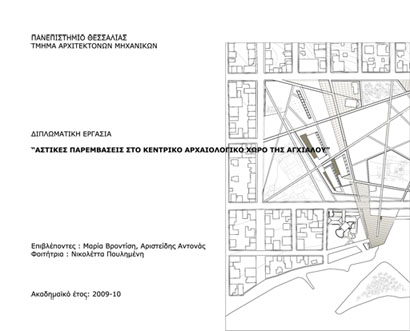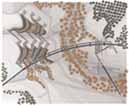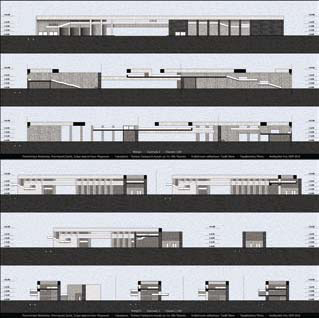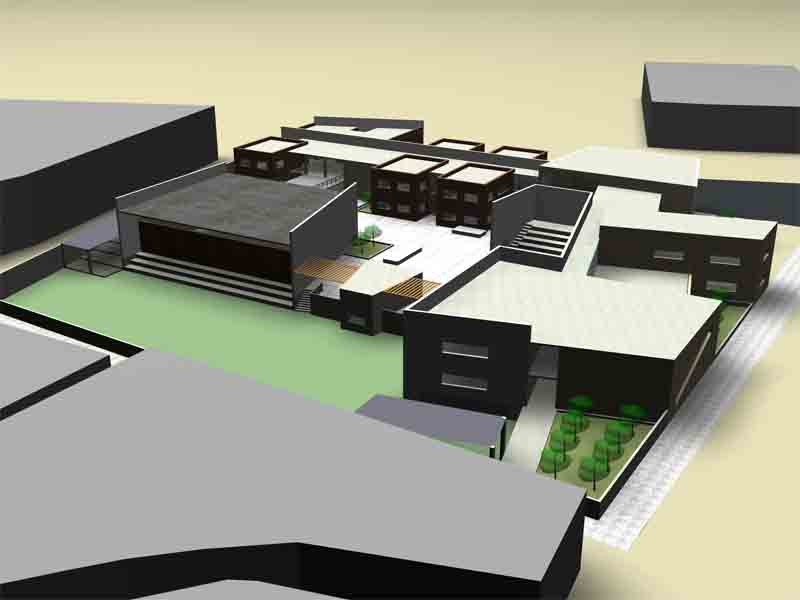

This dissertation concerns the town of Aghialos, specifically, the area that the central archaeological place of the town is located.
The management of the designing proposal deposits in three axes:
the landscaping of this area, the creation of an archaeological museum and the detail design in smaller scale of specific parts of the interventions.
As far as the architectural planning of this area is concerned, it is initially proposed the division of the area in smaller subregions and then the definition of their uses as well as the creation of road networks for pedestrians that will correspond to their needs for crossing the area, for visiting the new uses and for wandering over it.
The design of the museum aims to organize, preserve and conserve the archaeological findings as well as inform and educate the visitors.
The design in smaller scale concerns the loadbearing system of the museum as well as the structure of the proposed road networks.
The main purpose of the proposal is to convert this area into an archaeological park in order to offer the visitors and the citizens the triptych: recreation, education and culture.
An important aspect is the build environment to be in harmony with the natural one. The linings, the form and the structure of the interventions should ensure the cohesion of the architectural proposal.
Supervisors: Vrontissi Maria, Antonas Aristide
Reference Number: 253


For millions of years public space and buildings coexist and form a unity. The every day movement of people in the city is connected to an alternate series of natural experiences and landscapes that constitute the urban environment. The manifestations of every day life
That satisfied the need for association and collectivity were housed in the public space of
Square-parks. The square was , apart from a point in the space network, the basic element
Of the social, political and cultural network of the urban environment with the main demand
Of the appropriation of the city-dwellers.
At the same time, the railway since the 19th century in simultaneous development with the booming of the industry, ended up being the most popular means of public transport. rendering the railway stations the role of the “urban gate”. Places of gathering, sentimental feeling and in many cases, they embody athe narcissistic need of the city to become known. It constitutes one of the most important urban areas of municipal activity that is usually surrounded by multi-functional public places.
The advancement of the railway and the relatively structured places seems to have been behind in Greece, as the railway network is in need of modernization and requires the incorporation of more functions compared to the old stations. The sense of decadence that the railway in Greece presents must drastically change to follow the example of the railway development abroad.
Contemporary society is seen more and more as mobility , as transmission of information that continually changes and is translated into constant movement.
The aspects of flowing and dynamic character are introduced in the architecture.
The study presented here proposes flowing forms, inspired by the existing morphology of the particular space but also by the effort to monitor the mobility of the means and the ideas connected to it. In a railway terminal everything is in motion, the passengers , the employees, the cargo , the train itself. The main expression of this incorporation is the circle, the curve . the ellipse, forms that try to depict and describe motion. The secondary system of design is related to vertical routes that are governed by a periodical rhythm in the designing of the sectional view based on the escape that the city network dictates.
Considering the role that a railway terminal plays in a city , we can confirm the need to constitute a metropolitan centre that can recognize and fulfill the needs of any number of passengers as they change in time. However, a terminal in the concept of an urban gate must be surrounded by a variety of functions but also, by important for public use space. Therefore, we propose a network of pathways , accesses and communal space junctions. This network should provide fast and effortless transportation, connections and optical exits to and from the surrounding urban network as well as, the construction of multi-functional centres as points of reference and social gathering.
This project is situated in the centre of Patras, a focal point in the country for commerce and communication with Italy and the western European countries. It is an urban point of interlocal climax. It deals with the remobilization of an abandoned area in Patras, the old machine-works of the national railway company , OSE.
Today, it is a boundary point in the connection of the coastline to the city,a main entry area to the city. The area of Saint Dionyssios was the starting point of the first electric tram routes in Greece. The remaining railway tracks as well as the old carriages are still in the area of the study. The OSE plans for the modernization of the area of study include an underground way that will go under the existing tracks and the construction of a modern commercial terminal.
The proposed reconstruction of the area, based on the OSE requirements for underground railtracks, places the train activity underground, the entrance to the railway terminal opposite to the port terminal providing a view of the urban space and offering direct access through the main traffic highway. After the plan of the terminal, by moving up to the next level we can find a restaurant and an open area contained by walls which is proposed to facilitate free commerce as well as metal kiosks for short-term housing of sellers. Perpendicular to this area we propose the creation of a unit of overnight accommodation for travelers or visitors. All the constructions are covered by a system of horizontal panels. There is also an open –air square with transparent glass seats and “cracks” in the ground providing abundant natural light in the terminal.
On the other side of this space there is an area with trees as a stop point, a drink-and-snacks shop in the horizontal axis to the temple and a level where the old steam engines are on display. In addition, we propose the construction of an amphitheatre and a corridor covered by an artificial level of water. Our suggestion is to reuse the old carriages for commercial needs as well as, to construct a bridge in the form of an elliptical ramp connecting the area to the port terminal area. Finally, there are a lot of green areas proposed, with greenery and flower beds.
The aim of this proposal is to upgrade the quality of life, to provide specific traffic lines and their allocation in the area and in addition to offer mobile and visual access to the entrance and exit points, using as a tool, a people-centred design with forms that incorporate the modern way of life. These forms interpret movement, transport and transition as image. The proposal also aims to create different settings, the element of wandering and to express the purpose to create a city that relates to its dwellers.
Supervisor: Triantafillidis Giorgos
Reference Number: 270


The current project is located in the region of Gorgopotamos bridge which constitutes a part of the railway line Athens- Thessaloniki.
The bridge is 211 meters long and 30 meters high above the river Gorgopotamos and connects the two slopes of Oiti mountain.
Apart from the unique geomorphology of the region, whose springs are of great hydro- biological interest, the field of the bridge is also a landscape of collective historical memory.
The bridge’s construction was completed in 1905. During the Second World War it was blown up three times. The second blowing up was executed by the two parties of national resistance in 1942. The date of the bridge’s blowing up was consecrated as an official commemoration of national resistance by the Greek government in 1982.
It’s a landscape that combines the natural habitat with the human made environment and the historical memory with the dynamics of a productional region.
The project includes a net among historical research, cultivation and inhabitation in the south side of the bridge. A research center in biological pisciculture is situated in the north side. So we have created two related poles which supply each other. A footbridge connects those two poles which connect with the surrounding environment through other motion nets. The bridge constitutes a memory layer and a train’s receptor which supplies the installation.
We intend to create a self-sufficient landscape zone where the inhabitants have the possibility to research, cultivate and be a part of this system of memory and production.
Supervisors: Kotionis Zissis, Kouzoupi Aspassia
Reference Number: 292


The present dissertation is a study on the urban area of Peiraios Avenue and refers to the creation of four public spaces in a series of sites (Faliron area, Moshato area, Tauros area, Gazi area). Peiraios Avenue constitutes the main road connection between downtown Athens and the port area of Peiraias, as from the early antiquity it connected the ancient Athenian “asty” with its seaport. Moreover it was surrounded from the “Makra Teixi”, the Long Walls Fortification of the city, strengthening its significance as an unbreakable road axis in the byway of years.
In the newer development of Athens Urban Area, Peiraios Avenue was transformed into an industrial and merchant axis, hosting a plethora of factories and warehouses on both sides of the road, while on its sides urban neighborhoods of different character start to appear and develop. The diversity of urban landscape around Peiraios Avenue is reflected in an abundance of events and activities in various sites: at the beginning of the Avenue at Peiraias an open market takes place every Sunday, at the Texnopolis area the rag collectors of Athens organize an open bazaar, while a series of malls, office buildings, culture facilities and organized housing areas give the tone for the urban areas in between the edges of the avenue.
Taking advantage of the variety of activities per area, the proposed constructions have a double identity: both as passages (people’s crossings due to the heavy traffic of the avenue), as well as sites for the accommodation of local public activities. More specifically they consist of a group of open and closed spaces, colonnades, enclosed courtyards and stairways, which create small protected neighborhoods for future users of the sites. In each of the four sites the proposed constructions play the role of a modern “Wall”, in remembrance of the ancient Wall ruins, which do not however separate or seclude, but instead connect the opposite urban areas and facilitate the passage of residents, breaking effectively the continuous and rigid limit of the avenue.
At the Faliron area the construction proposes the accommodation of a substantial part of the Sunday’s open market, at the Moshato area the operation of a small open market for fruits and vegetables in contact with the neighboring main Athens fruit market, at the Tauros area the creation of a meeting and trading place for local residents, while at the Gazi area the proposed construction is a new small square for the rag collectors association. In any case, the existence of large open spaces, with minimum building infrastructure, makes it easier for the users to take full advantage of the interventions, based on their uses and particular needs.
As part of the dissertation research, a successive photographic impression of the avenue and its neighboring urban areas was created, followed by the urban analysis of the individual sites of the project, and finally by the creation of sketches, drawings, models and depictions of the proposed constructions, that attribute the philosophy of the intervention in total.
Supervisor: Trova Vasso
Reference Number: 294


Location:
The location of the Jr. High School is in Anavros Volos, below the hill of Goritsa. In this area we find other school complexes and, as in G. Dimou the area constitutes an essential education center for the city. The plot lies at Apollo St., Perseos St., Sirinon St. and Orminiou St. On the Southwest it borders the Athletic Center of the area, Apollo St., and residences on the other facades, while Perseos St. and Sirinon St. do not get any traffic because they are service roads for the vehicles of the opposite residences. On this site we already find the 2nd Jr. High School of Volos and the study constitutes a reconstruction of the existing school building. On this site we are considering a 12-classroom Jr. High School for 360 students, meaning 30 students in every classroom. The building follows the building program of the Organization of School Buildings.
Key objectives:
The aim was to avoid any pitfalls that are frequently found in school buildings and which are unpleasant elements for the students such as the “prison” school model where the building is organized is such a way so as to intensely supervise the students. Another objective was to create a way to protect the private space from the public space without extensive use of high railings that we see in almost all schools. Also, a primary axis was the free design of the teaching areas so as to avoid the feeling of being in a “hotel”, but also free movement of the students within the school grounds. Since the courtyard is obviously such an important element in the everyday life of the students, as it is both a playground and an area for socialization, it should have a leading role in the layout design of the school. The aim was for the concept of the courtyard not to be strictly set in a very specific area so that the student does not have a sense of containment but to create multiple areas of socialization where the student can find his own corner and where he would not have, to a great extent, the constant supervision of teachers.
Main Idea and development:
With these principle axes we searched for a structure that can give us a model that would meet the above requirements. Hence the idea of a corrugation which bends within a space which to a certain extent was modeled on the “privacy conditions” it created. From this corrugation we kept only a few elements based on the movements that were created and with the intent to have as a result some visual escapes at points of interest. The building volumes are arranged around and on this corrugation and their floor plans are shaped by two main axes which relate to the relationship between the plot and the main street and the athletic center respectively. The observer can walk and take in the whole situation that arises from the recesses and protrusions of the folds since the volumes are integrated by a common, legible element that is bridging. To satisfy the initial objective for free movement from and to the classrooms, access to the classrooms is outside and independently for each classroom. From the way the main building volumes are organized result four courtyard areas that become more distinct through small height differences and use of different materials. The reason for the formation of multiple courtyard areas is for the student to find different places of socialization, each corner with a different identity and which may be associated with the classrooms in which each class is taught.
Supervisor: Papadopoulos Lois
Reference Number: 295


The objective of the diploma project is to look into and strengthen through designing the relation of the disabled person with the social as well as the natural environment. The starting point of the structure is epitomized by the concept of the coexistence of the natural and artificial environment, of the old and the new. By extension, the relation between living with nature and the relation of man and nature are two parameters that also comprise the designing purpose, so that the disabled person can be in constant contact with the natural environment, which is a source of harmony and balance. The designing goals of the diploma project, apart from the functionalism, the appeal of the architectural suggestion and the flexibility, are the interrelation of the residence with the environment, that is the coexistence of the natural and the artificial, the old and the new as well as the easy access and service of the person with motion disability. The first geometrical linings of the structure are dictated by the existing elements which determine the physiology of the building block, like the limits of the building site, the existing architectural elements of the area, like the old stone walls, as well as the maintaining of the existing plants. On a secondary level, follow the geometrical linings dictating the organization of the ground and the limitation of the transitional spaces. The linings are formed in such a way so that the core of the structure which is the central transitional space is emphasized.
The building is based on a synthetic construction with internal dynamics which comes from the combination of the architectural volumes, the outdoor and semi-outdoor spaces and the crossing axes. Special emphasis on the total synthesis is given to the quality of the outdoor areas which are defined by the building construction mass, as well as the variety of the micro-environment which these units define.
Supervisor: Manolidis Kostas
Reference Number: 255


The title of this study is "Conversation with the hill, a course of immersion and emersion towards the fort Karambamba in Khalkis". The location of our study stands in the biotik side of the town of Khalkis. This location is the hill Karambamba, a hill from which top someone can observe the town of Khalkis and the two Evoik gulfs.
At the top of the hill stands the so called "Fort Karambamba". This fort was designed by the Venetian builder Gallot for the Othomans during the Venetian-Turkish war that started in 1684.
This location is very interesting today. It is located near the strait of Evripos and the bridge of Khalkis. Also here we can find Khalkis trainstation. So we can say that it is a door to Khalkis. In addition the fort at the top of the hill gives a chance to observe the landscape from a high spot and it used for walking and for various artistic events.
Our intention was the designing of a course that would lead from the trainstation to the fort. The cause for this suggestion was the absence of an interting walking route towards the fort. The designing of such a course would give us the chance to work with the interesting landscape of the location, the views and the relation with the sea.
The most significant element that led us through this study is that the hill and mostly the fort give the chance of various views to the landscape. Looking at the forts history and placement we can say that it was designed to work as a tool for viewing.
Supervisors: Kotionis Zissis, Kouzoupi Aspassia
Reference Number: 271


In this thesis we proceeded to redesign the building that houses the cafeteria and a series of interventions in the general area of the ski center Agriolefkes Pelion. The choice of the theme of my diploma was after a tour in my area. Then, recognition was to join morphological, conceptually new building on the existing natural environment.
The ski is in a forest Agriolefkes of which has gotten its name. For the creation of the ski center up streets, lanes have been removed from the natural planting. These lanes could consider them as a continuum that begins from the road that connects the ski to the provincial network and then becomes the same as the tracks of ski.
The building keeping as a main component the strip created by folding it in space. The basis of the folding-building is the continuation of the road and the connection of the mountain strip with the building strip, represents a transition from outside to inside. Takes visitors inside in order to give back the sight of the mountain.
The building serves as an observatory. These tumors are facing the ski slopes while looking the Sea of Pelion. Each volume is facing a different angle. The space is the main bar has visual contact with the track pillars and the track of beginners. The area is the second bar, rooftop looking Pagasitic on one side and the track of beginners and low vision to track Thetis.
In the building there are no walls except those created by the same folding. All partitions required for the formation of internal space (restrooms, storage, etc.) are made from different materials and do not reach the maximum height of the floor in order not to interrupt the continuity of the hinge. The lift is a separate volume of the building connecting with bridges.
Supervisor: Papadopoulos Lois
Reference Number: 308

